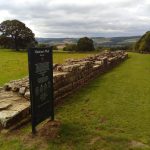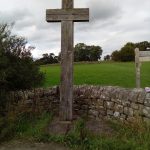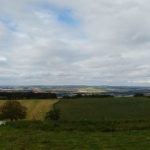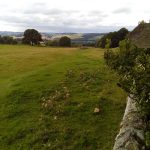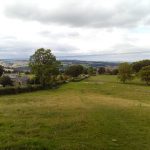
A free Sunday gave me a chance to recce the Wall and Heavenfield walk. I previously guided this walk a few years ago and decided to add this shorter but very varied walk to our programme.
The Walk

I started by walking through the village and up through fields to Fallowfield Farm. From here the walk takes us to Heavenfield and the beautiful St Oswald’s Church. Within the grounds there is an information board identifying the Cheviots to the North.
From here I visited the 15 metre-long section of Hadrian’s Wall, called Planetrees, A short section of woodland brought me to a minor road and back to Wall.
This is a beautiful 5 mile walk with lots to see.
Wall
 The village of Wall in North Northumberland takes its name from nearby Hadrian’s Wall.
The village of Wall in North Northumberland takes its name from nearby Hadrian’s Wall.
A focal point in the village is the outstanding Church dedicated to St.Michael.
The church occupies a quiet position in a picturesque tree-lined churchyard.
In the centre of the village is The Hadrian Inn, a 19th-century ivy-clad hotel. This is where we will be going for refreshments after the walk.
Heavenfield
 The village stands near the site of the Battle of Heavenfield.
The village stands near the site of the Battle of Heavenfield.
The Welsh army under Cadwallon ap Cadfan attacked Oswald’s army. Oswald was King of Bernicia, part of the Northumbrian kingdom. The armies met around AD 633 and the result was a decisive victory for Oswald. As a consequence of his victory, Oswald was able to unite the Northumbrian kingdoms of Bernicia and Deira under his rule.
A settlement grew up at Heavenfield, with its own church. The villagers of Wall had to walk the 1.5 miles to worship at Heavenfield. In 1896 the Victorian church of St George was built on the village green and replaced an earlier cottage thatched with heather.
Several interesting sections of Hadrian’s Wall run close to the village. Just to the north is Brunton Turret, and to the northwest is a milecastle. Chesters Roman Fort is a mile away.
St Oswald’s Church
The present building is probably the third on the site of what is believed to be the location where King Oswald (604-642) raised a large wooden cross before the Battle of Heavenfield (AD 635). There is a wooden cross in the place near the assumed site of the original cross.
A Short Description of the Church
St. Oswald’s stands in a churchyard set in the middle of a field.
The church itself has a simple chancel which is divided at the west end into a vestry, the rest being the body of the church. On the roof there is a simple belfry-arch for the single bell, rung during services. There is an unusual feature of a sundial on the south wall.
The interior is of limewashed stone without any plaster, with a font set near a Roman altar that had been re-used as a cross base .
The most unusual feature to the 21st century visitor is the gas-lighting with its mantles and glass-shielded burners in the roof, and the candle-holders set in the walls. These and the old American harmonium show that St Oswald’s has never been connected to electricity, mains gas or water supplies, and witness the modest background of this tiny church.
An excellent display on the history of both the church and the battlefield is in the vestry.
Planetrees
 This length of wall is important for what it reveals about a change of plan that took place during the construction of the Wall. The Wall’s width was narrowed from 10 to 8 Roman feet – probably to speed up building. At Planetrees the narrower Wall sits on top of broader foundations.
This length of wall is important for what it reveals about a change of plan that took place during the construction of the Wall. The Wall’s width was narrowed from 10 to 8 Roman feet – probably to speed up building. At Planetrees the narrower Wall sits on top of broader foundations.
I hope to see you at the Wall and Heavenfield walk on 23rd September.
Julie




